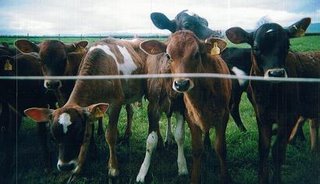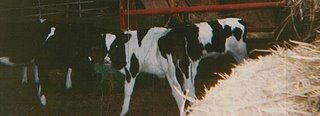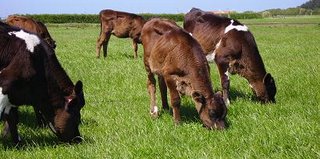Pre-ruminant calf nutrition
The various calf feed companies have spent this spring mudslinging amongst themselves with greater vigour than usual, contradicting each other in the name of Science.It’s no wonder the ignorant farmer is confused. The information he needs to make decisions is held securely by the salesmen of the large companies. The laws of Nature have changed, they tell him, and he can no longer expect to produce a healthy calf without their product.
Nearly a decade has passed since I was able to walk into a local library and obtain the latest in animal research. Like everyone else, I’m dependent on the information obtained through the rural press, from vets and from the feed salesmen. Any observations contracting their wisdom are merely that – personal observations, anecdotal evidence and of no import.
And pictorial evidence, of course.

“Give them the right stage colostrum for their age,” PWD emphasises. As much day one colostrum as they can drink, offered twice daily when they come into the shed. Second and third milking colostrum on their second day and older colostrum until 5 – 7 days old, when they are moved to the other shed and fed once daily with access to grass, shelter and good quality hay.
That’s it. Plenty of milk, plenty of grass, wean at two months old and keep offering them the young, leafy grass ahead of the cows until they’re eight – ten months old.
I’ve never seen better calves yet.


These are my calves, 2004 (Xbreds) and 2005 born (Jerseys). They’ve been reared on a restricted milk/ ad lib meal system (4 litres/calf reconstituted milk powder) and weaned at 65 kg and 6 – 7 weeks old (2004) or 8 – 9 weeks old (2005 following rotavirus outbreak). They were put out to grass for the first time at three or four weeks old and ate increasing rates of meal (up to 1 kg preweaning, increased to 1.5 or 2 kg) until weaning, then reducing rates until ten – twelve weeks old. Each group of fifty calves munched through one large round bale of hay, offered adlib, before they were twelve weeks old. Meal used – NRM Moozlee and NRM Grow-up, about 35 – 40 kg per calf.

The 2006 line were moved on to whole milk at around a week old, offered 6 litres a day with adlib meal and hay until about four weeks old, when they were cut back to four and a half fed once daily and let out to grass (the later born calves were at grass from around a week old). The milk was cut back again to three litres when the stored colostrum ran out and the first calves weaned at eight to nine weeks old and 70 – 80 kg.
In spite of being offered fresh meal daily, they’ve eaten about 6 – 7 kg a calf pre-weaning and I’m still trying to persuade them to munch through the last four bags and wondering when to call it quits and just offer the stuff to the dairy cows. They eat more meal when they don’t have access to large quantities of sweet grass. Meal used – StartUp 3 – 4 kg per calf, FinishUp about 4.5 kg per calf thus far. They’ve eaten the usual 5-bale equivalent of hay per 25 calves.

A milk/meal/delayed forage system – though not as delayed as some rearers who would keep their calves inside until weaning. These calves are fed large quantities of milk (5 – 7 litres) for the first three weeks, then reduced milk is offered and meal consumption increases. Calves are reared on NRM Moozlee and go out to grass at five or six weeks old, weaned at eight to ten weeks.
I don’t have photos of calves reared on the ChaffHage system (Lucerne silage), though I have worked briefly on farms that reared their calves that way – calves looked fit and healthy. Likewise I don’t have photos of the calves reared on my farm last year – which I had nothing to do with beyond training the babies and turning healthy four day old calves over to the ‘official calf rearer’ to destroy *shudders*. That system was 3.5 litres of milk once daily, adlib meal (looked like a chipped grain mix) and calves weaned from deep wet compost onto grass and continued meal feeding at five to six weeks and 65 kg on the weigh band (Fr bulls). Calves did not look fit and healthy.
Recently calf rearers across New Zealand have been incorporating palm kernel extract into the calf feed (and it’s also included in the mix produced by the large calf meal companies). I haven’t seen calves reared this way, but I’ve been told they grow well.

These calves are raised in group pens on deep straw beds, and offered 2 – 3 litres milk twice daily until four or five weeks old, then trough-fed milk for as long as it is available, until three to five months (if I recall correctly). They have adlib hay and home-mix meal (rolled barley, maize gluten, distillers grains and sometimes sugarbeet/soy products, fortified with minerals) until turn out in spring (May, Scotland). Because of the long winter and AYR calving, the calves range from three months to twelve months when first turned out to grass, and the older ones will have been fed silage indoors rather than hay. Meal feeding is almost lifelong.
*note* Because of the milk quota system in place in Britain, it is cheaper to give milk that is surplus of quota to calves five and six months old than to supply it to the dairy company. Farmers would even feed it to their cows, as a reasonable alternative to tipping it down the drain or paying the penalty for being over their quota.
Rather than being confused by the science, if we look at the basics of calf rearing the aim is to achieve two things: first, a living, healthy calf; second, a functioning rumen that will allow the young animal to get most of its nutrients from forage.
A baby calf cannot survive on hay or grass any more than you or I can. So first of all, to keep our calf alive it needs energy that doesn’t come from forage: colostrum first, to stimulate the digestive system and provide immunity and energy, then milk for energy and growth.
That keeps the calf alive. Until it’s around a week old that’s all it will be interested in – I’ve never succeeded in persuading a calf less than that age to eat meal or hay or drink water from a trough in any significant quantities.
At about a week old, if it was outside with its mum the calf would be drinking from her at least twice daily and will start to nibble at the grass and any other vegetation it finds. From now on it will spend increasing amounts of time grazing and by about three or four weeks old, will chew cud when resting. The suckled calf is weaned at six to nine months old far bigger and fatter than any hand-reared calf of the same age – and with a fully functioning rumen.
Not all calves are lucky enough to keep a mummy cow all to themselves for their first six months of life – but the principles are the same. Give them a food they can digest that will provide for energy and growth, for at least the first eight to ten weeks of life, and allow them access to a feed that will stimulate rumen development. Grass will do it. Hay will do it. Chaffhage will do it also. The meal companies tell us meal will do it (I’m inclined to be suspicious on this one, because I’ve never seen calves regurgitating to cud on their meal). They love clean straw, or a sweet dry silage.
From 3 – 4 weeks old, calves have a strong drive to eat anything long and stringy. If they can’t have grass or hay, they’ll chew the rearer’s hair or their bedding or the fenceposts.
So why do calves need meal?
Meal fits into a calf rearing system in a number of ways. It can be an energy substitute for milk, allowing early weaning, lighter weaning or a restricted milk system. It’s a balanced diet, with protein, carbohydrate and usually a sweetener (molasses or sugarbeet pulp) for palatability. The companies producing bagged calf meals fortify it with minerals and a coccidiostat, to help maintain the calves in good health.
It can be used to help the calves get through weaning without a growth check.
It’s useful for making them follow you.
But it’s not an essential. The main advantage of meal is in reducing the amount of milk fed to the pre-ruminant and developing ruminant animal. And once the animal is keen on the idea of eating meal, it can be provided as an energy source at any point in its life.
In a group of calves at risk of coccidiosis, it’s an easy way to administer the preventative. But all is not lost if the farmer chooses to not feed meal – the coccidiostat added to calf meal is bovatec. It’s available from the vet, and can be manually administered to the calf (not a pleasant job, believe me. On one farm I saw coccidiosis every year when trying to wean the calves off meal) or mixed with other feeds (not fluids unfortunately).
Baycox is an oral drench effective at treating coccidiosis – now certified for use in calves. I’ve been told it also has some preventative effect.
My biggest problem with coccidiosis has been trying to convince a vet or vet receptionist of my ability to identify it without calling a vet out, waiting 48 hours for faecal lab tests and then obtaining the appropriate treatment (without being fobbed off with antibiotics by some vet who doesn’t believe a farmer can distinguish between bacterial scours and coccidiosis on a farm with a history of coccidiosis) – by which time the affected calf is much less likely to recover quickly. It’s worth speaking to a vet before calf rearing starts to have Baycox approved for coccidiosis – suspected in all cases of very watery scours, calf discomfort and straining or tail twitching and/or blood in scours or when straining. A severely affected calf can become dehydrated very quickly.
Coccidiosis is caused by protozoa and will not be controlled by antibiotics.
I’m going to put myself in line for all that mudslinging by saying that calves do not need meal to survive as healthy animals, or to develop a functioning rumen at an early age. Give them grass, give them hay or whatever you like to satisfy their appetite and grazing instinct – and if possible, introduce new feeds gradually (not that I'm criticising ther many farmers who prefer to put them out to grass for the first time at eight weeks old and see them disappearing through all the fences. Not at all).

Mid-October. The calves are ten weeks old.



2 Comments:
Hi was looking at your site because I was looking for advice, I was watching one of my calves today, hereford x heifer, she seemed to be chewing cud but losing it? she's about 3/4 wks old.
Hi Kate,
That sounds about right. At 3 - 4 weeks old she's not really a ruminant yet, but she will be ready to try foods that stimulate the rumen to work.
I'm certainly not the expert on this, but around three weeks old is when I usually expect to see the calves ruminating as they lie down, provided they're being offered hay or grass. General industry advice is that they're twelve weeks old before they can thrive on grass alone (though I'm certain the meal companies are pushing that figure at us. It effectively means they have to be fed either milk or meal in addition to forage until twelve weeks old.)
abstract of chaffhage versus grain pellet rearing
Post a Comment
<< Home